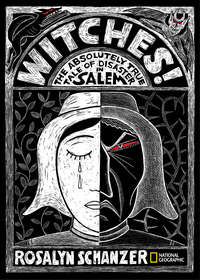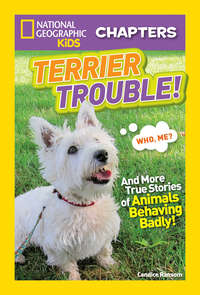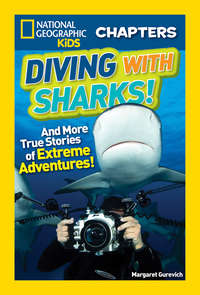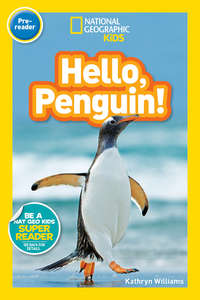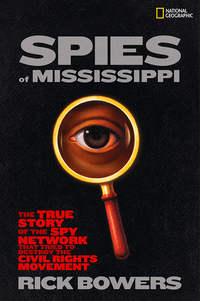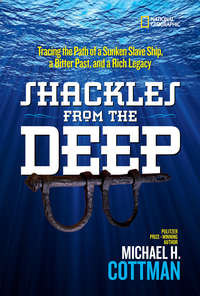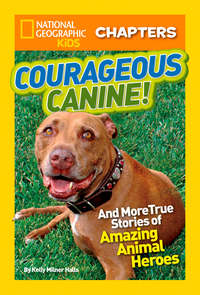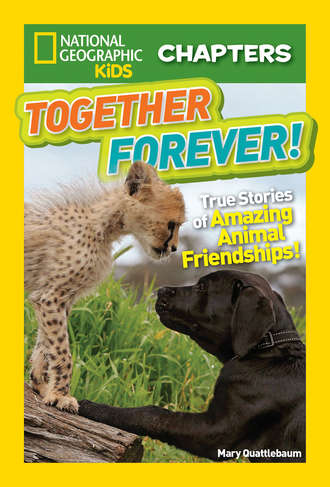
Полная версия
National Geographic Kids Chapters: Together Forever: True Stories of Amazing Animal Friendships!

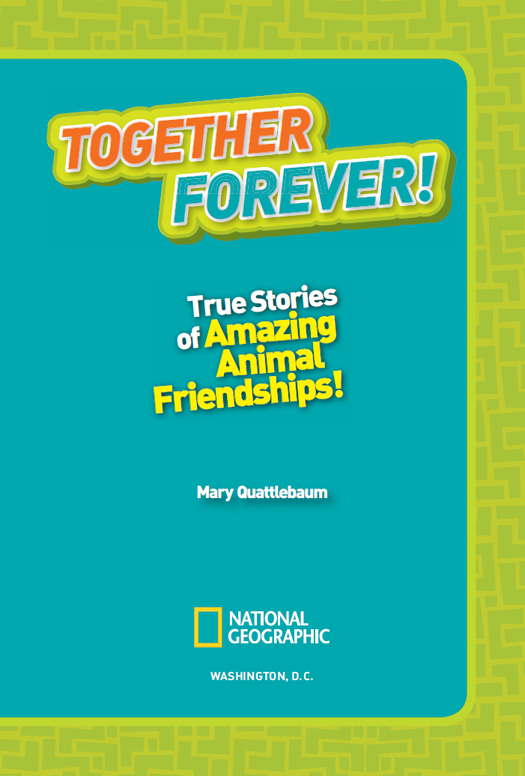
Copyright © 2016 National Geographic Partners, LLC
All rights reserved. Reproduction of the whole or any part of the contents without written permission from the publisher is prohibited.
Since 1888, the National Geographic Society has funded more than 12,000 research, exploration, and preservation projects around the world. The Society receives funds from National Geographic Partners LLC, funded in part by your purchase. A portion of the proceeds from this book supports this vital work. To learn more, visit www.natgeo.com/info.
For more information, visit www.nationalgeographic.com, call 1-800-647-5463, or write to the following address:
National Geographic Partners
1145 17th Street N.W.
Washington, D.C. 20036-4688 U.S.A.
Visit us online at nationalgeographic.com/books
For librarians and teachers:
ngchildrensbooks.org
More for kids from National Geographic:
kids.nationalgeographic.com
For rights or permissions inquiries, please contact National Geographic Books Subsidiary Rights:
ngbookrights@ngs.org
NATIONAL GEOGRAPHIC and Yellow Border Design are trademarks of the National Geographic Society, used under license.
Art directed by Callie Broaddus
Designed by Ruth Ann Thompson
National Geographic supports K–12 educators with ELA Common Core Resources. Visit natgeoed.org/commoncore for more information.
Trade paperback
ISBN: 978-1-4263-2464-2
Reinforced library edition
ISBN: 978-1-4263-2465-9
Ebook ISBN: 978-1-4263-2466-6
v3.1
Version: 2017-07-11
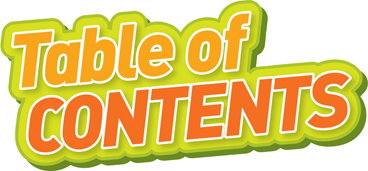
Cover
Title Page
Copyright
PENNY AND ROO: On the Move!
Chapter 1: Hospital Helpers
Chapter 2: Pup in Peril
Chapter 3: Let’s Go
MR. G AND JELLYBEAN: A Strange Case!
Chapter 1: What’s Wrong?
Chapter 2: Reunion
Chapter 3: New Friends
SIRI AND IRIS: Best Mates!
Chapter 1: Becoming Buddies
Chapter 2: Play Ball
Chapter 3: A Cheetah’s Best Friend
DON’T MISS!
More Information
Dedication
Credits
Acknowledgments
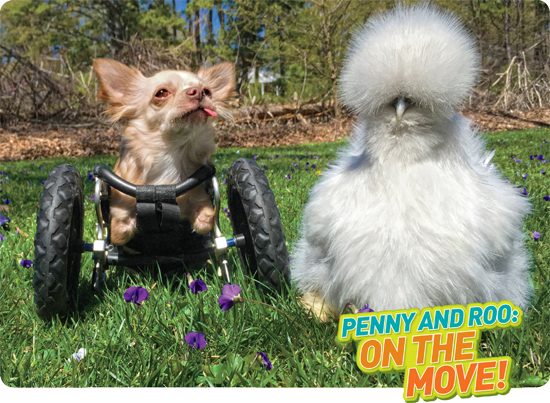
Penny is a chicken. Roo is a dog. They became fast friends. (photo credit p1.1)
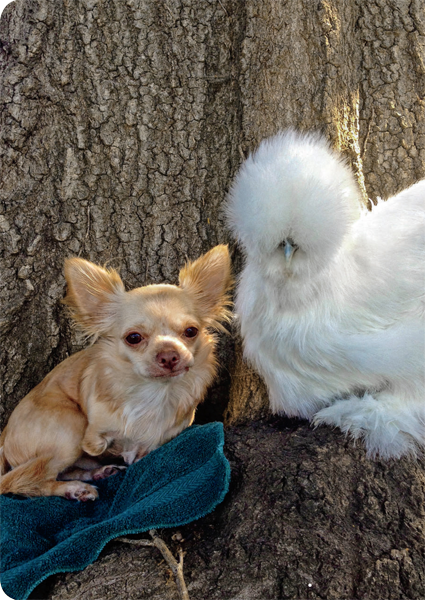
Penny and Roo met at the Duluth Animal Hospital in Georgia, U.S.A. They’ve been attached ever since. (photo credit 1.1)

Dogs strain at their leashes. Cats meow in their carriers. A fluffy chicken scampers by in a diaper. Then a tiny dog wheels past in a special cart. The front desk of the Duluth Animal Hospital is busy! Many animals are brought here if they’re sick or injured. The veterinarians (sounds like vet-er-ih-NAIR-ee-enz) here treat all kinds of animals.
Their patients include dogs, cats, hamsters, lizards, turtles, even chickens. They help their animal patients feel better or give them shots to keep them from getting sick.
But the chicken and the little dog—called a Chihuahua (sounds like chi-WAH-wah)—aren’t patients. Penny and Roo work here. These two best friends welcome animal patients and their owners to the hospital in Duluth, Georgia, U.S.A.
The hospital staff appreciates their good work, especially Alicia Williams, their owner. Alicia works here as a receptionist. She helps patients prepare for their visit with the vets. So do Penny and Roo. Sometimes the patients are frightened or in pain. Their owners are worried.
But then Penny does something silly. She steals Roo’s treat and trots fast, fast, fast on her feathered legs. Roo chases her and tries to grab the treat back. People smile and laugh. The two friends are so funny that they help everyone—animals and humans—feel more relaxed.
Penny and Roo have been working together for three and a half years. How did these two unique friends get this special job? Penny came first. Alicia met Penny when she was taking a class in animal science. Alicia had to learn about what happens when animals are used in research, and she had to visit some places that did this work.
Research is an important way to learn more about both animals and humans. Here’s how it works. Scientists study a small group of research animals. They give the animals in the group a special diet or medicine. Then they carefully observe, or watch for, changes in the animals. Do the animals grow bigger? Do they get better?
The scientists gather the information. They write papers about what they have learned and publish them. Other people can read about their research and learn how to improve the food they grow or the medicine they make or give. Scientists and doctors often learn about the effect of certain medicines on humans by looking at how the medicines affect animals.
Penny was a research animal in a study on diet. Alicia saw her on the last day of the study. Now that the research was done, the scientists would no longer need her.
Did You Know?
There are more chickens—20 billion—than any other birds on Earth. They lay a trillion eggs a year.
Alicia looked at the young chicken. Penny was a beautiful hen! Instead of smooth feathers like most birds, hers were soft and fluffy. The feathers on her head and legs looked like a puffy hat and pants. Alicia wanted to give the hen a new home. “May I have her?” she asked the researchers.
And that’s how Alicia ended up bringing Penny to the house she shares with her parents, three sisters, five dogs, two cats, and four parrots. Everyone in Alicia’s family is an animal lover!
At first, Alicia didn’t know how to care for Penny. Parrots and chickens are both birds, but they require different care.
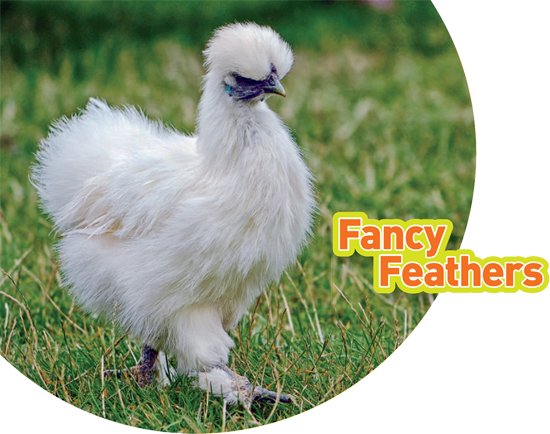
(photo credit 1.2)
Silkies are unique chickens, with soft, silky feathers. They have black bones and black skin. They don’t look very much like the jungle fowl that all chickens are descended from. One of their distant ancestors is the Tyrannosaurus rex! Silkies have some special traits. They have five toes instead of the usual four, and they have blue earlobes. They can’t fly. Silkies like to brood, or sit on their eggs. They will even hatch the eggs of other birds.
Penny was also not a regular chicken. She was a fancy, gentle type called a silkie.
Alicia’s boss, Dr. Mike Miller, was very helpful. He’s a veterinarian. He told Alicia that chickens need special food and plenty of time outdoors. Alicia made Penny an outdoor pen so that she could scratch at the ground and search for bugs and seeds to eat.
But because Penny is very friendly, Alicia also made her an indoor pen. Chickens are flock animals and like to be with other chickens. With an indoor pen, Penny could be around the other pets and people in the house.
Penny quickly settled into her new home. Except that she didn’t want to stay in her pen! She wanted to explore the house. But a chicken poops a lot, and Alicia didn’t want to be cleaning up all the time. So, she tried putting a little diaper on Penny. It worked! Penny had her freedom, and Alicia didn’t have a mess. What a good idea!
Did You Know?
Chickens make many different sounds.
A squawk might show fear, a purr contentment.
A rooster’s crow means “This is my territory.” Hens often say bawk when they lay an egg.
Now Penny could follow Alicia everywhere. She even learned to come when she was called. Alicia soon discovered that Penny loved to cuddle, too, unlike her parrots. Penny especially enjoyed sitting in Alicia’s lap.
To show her pleasure, she would make a soft sound, like the purr of a kitten. But when Alicia went to work, Penny was lonely. She missed her favorite human.
So, Alicia had another good idea: She would bring Penny to work. Penny and her boss thought it was a good idea, too.
Penny felt so comfortable at work that she soon started laying eggs at the hospital! Like Penny, these eggs are unique. Most chicken eggs are brown or white. Penny’s are small and pink.
Everyone loved Penny! Penny received lots of cuddling and attention. She helped people learn more about silkie chickens. Many had never seen one before. “What’s that?” kids would ask, pointing at the fluffy white hen. Sometimes they thought Penny was a kitten or a fancy dog!
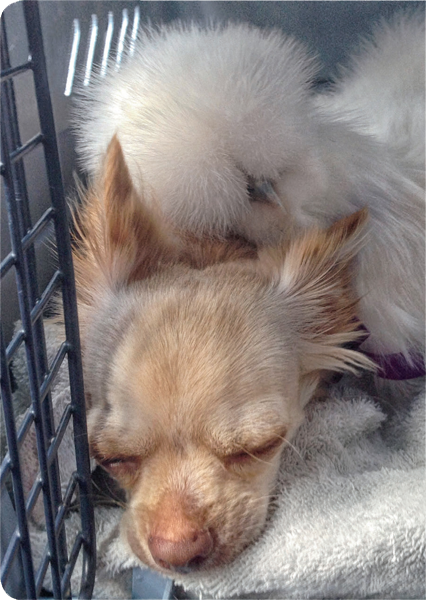
When Penny first met Roo, he was in bad shape. She sat on top of him to warm him up. Soon, they both fell asleep peacefully. (photo credit 1.3)
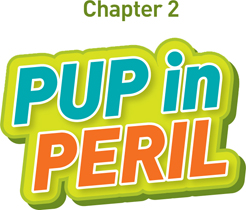
One cold February night, Penny was at the hospital when a man rushed up with a small bundle. What was inside? A tiny puppy! The man had found the puppy in a ditch at a nearby park. He had scooped up the shivering creature and hurried to the hospital. The man had hoped the staff there could help. They always took good care of his pets. The hospital staff was amazed. The puppy was so little! He was only six weeks old and weighed just two pounds (907 g). That’s about the weight of a quart of milk.
Did You Know?
Chihuahuas are the smallest breed of dogs. Adults can weigh about as much as a small bag of sugar.
He was missing the lower part of his front legs, several teeth, and a toenail. This pup would never be able to walk, run, or jump like other dogs. This dog could move from one place to another but only by dragging himself or hopping on his back legs. The puppy’s way of moving helped inspire his name. He hopped like a kangaroo, so Alicia named him Roo.
Roo’s past was something of a mystery. Alicia thinks that Roo was tossed in the ditch by a dog breeder. The breeder had probably wanted to sell this puppy for a lot of money. When he realized that Roo had so many problems, he decided to get rid of the pup. Who would want such a dog? Alicia would! And Penny, too.
When Roo was brought to the hospital, the hen was resting in her soft, pink bed at the front desk. Alicia tucked Roo in beside her. The warmth of Penny’s body would help warm and comfort the cold puppy.
Roo took one look at the big fluffy bird and pounced! The puppy began tumbling around. He chewed on Penny’s feet and feathers. He wasn’t hurting Penny, he just wanted to play!
“Penny wasn’t sure what to think,” said Alicia. “But when Roo settled down for a nap, Penny climbed on top of him, as if he were an egg. She warmed him up, and then they both slept.”
They’ve been best friends ever since. They eat together and share water bowls. When it’s time to go to the hospital, they travel in the same carrier. Sometimes they squabble like human brothers and sisters. They try to steal food from one another. Penny will steal one of Roo’s dog treats, even though she can’t eat it; and Roo will chase her.
Run, Penny!
Go, Roo!
What a game! The two play until they get tired, and then it’s nap time. When they snuggle, Penny purrs, just as she does on Alicia’s lap. Sometimes Penny even lays her eggs in Roo’s dog bed. This is a way that Penny shows how much she trusts Roo.
Did You Know?
The Chihuahua has one of the longest life spans of any dog. Most live 10 to 18 years. But many Chihuahuas live to be more than 20 years old.
Roo shares his toys with Penny, but his favorite plaything is still Penny’s toes and fluffy feathers.
“Their friendship seems to be very unusual,” said Alicia. Chickens are prey animals and dogs are predators. This means that chickens will try to avoid dogs. Dogs may chase or try to eat them.
Instead, these two friends look out for one another. Once Penny was sick for several weeks, and Roo stayed very close to her. He didn’t want to play.

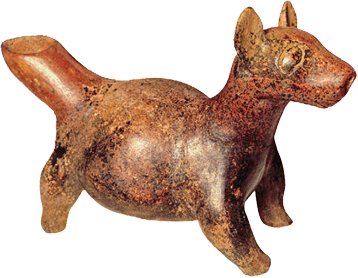
(photo credit 2.1)
Chihuahuas are named for the state of Chihuahua in Mexico. A few of these dogs were found there, close to some ruins, in the 1850s. The little dogs may have an even earlier history, though. Carvings and artwork that are more than 1,000 years old show a larger Chihuahua-like dog called a Techichi (shown below). These dogs seemed important to the ancient Toltec and Aztec people of Central America. Some lived in temples and were buried in graves. Perhaps they were part of religious ceremonies.
Did You Know?
There are two kinds of Chihuahuas: short-haired and long-haired. Roo is the long-haired variety.
And when Roo hurt his leg and needed surgery, Penny refused to leave him. She sat quietly by his bed until he recovered.
This is how Alicia explains the bond between Penny and Roo: “I think they were both little throw-away orphans in need of comfort and companionship, and they found that in one another.”
Most of the other animals at Alicia’s house ignore the two buddies—except for a pit bull named Lucy. She wants to take care of them. Lucy follows them around and bathes them with her tongue. Lick, lick, lick.
At 70 pounds (32 kg), Lucy is 14 times larger than Roo, but she always plays gently with him. She likes to poke and nuzzle. He likes to pounce and tug. Chihuahuas may be small, but they are definitely spunky!
Did You Know?
Chihuahuas shiver when they are cold, excited, or frightened. A dog sweater can help keep them warm.
Penny is part of the fun, too. She enjoys perching on Lucy’s back. She gets a nice ride that way.
And Lucy never jumps or tries to knock Penny off. The big dog acts like a gentle mother to these two unique babies.
When they are working at the hospital, Penny and Roo stay in the reception area. “This is their domain,” said Alicia. They greet animal patients, nap, and play with owners, their children, and sometimes the patients.
Yip, yip, yip, calls Roo in his squeaky voice. He’s a noisy little rascal and likes to grunt, bark, and growl playfully.
Penny is quieter and makes a variety of chirps. When Penny seems restless and starts poking into corners and at the pet beds, Alicia knows what’s going on.
Конец ознакомительного фрагмента.
Текст предоставлен ООО «ЛитРес».
Прочитайте эту книгу целиком, купив полную легальную версию на ЛитРес.
Безопасно оплатить книгу можно банковской картой Visa, MasterCard, Maestro, со счета мобильного телефона, с платежного терминала, в салоне МТС или Связной, через PayPal, WebMoney, Яндекс.Деньги, QIWI Кошелек, бонусными картами или другим удобным Вам способом.




